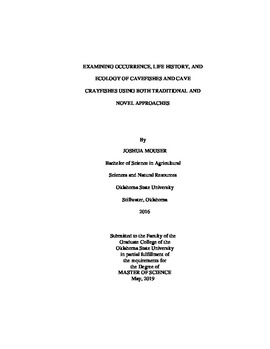| dc.contributor.advisor | Brewer, Shannon K. | |
| dc.contributor.author | Mouser, Joshua | |
| dc.date.accessioned | 2019-10-25T20:25:17Z | |
| dc.date.available | 2019-10-25T20:25:17Z | |
| dc.date.issued | 2019-05-01 | |
| dc.identifier.uri | https://hdl.handle.net/11244/321597 | |
| dc.description.abstract | The persistence of cavefishes and cave crayfishes in the Ozark Highlands ecoregion is threatened due to narrow ranges coupled with declining groundwater quality. To adequately address the threats to cavefishes and cave crayfishes we need to understand their occurrence patterns and their basic life history and ecology. It is often difficult to obtain those data for stygobionts because they occur in locations inaccessible to humans. New techniques and improved study designs can increase our knowledge of where cavefishes and cave crayfishes occur and how to best facilitate their presence. Therefore, my objectives were: 1) assess the use of eDNA to detect the presence of cavefishes and cave crayfishes while accounting for imperfect detection, and 2) determine habitat use, morphological traits, and longevity of bristly cave crayfish Cambarus setosus. I developed single-season occupancy models to estimate occurrence probability of cavefishes and cave crayfishes while accounting for imperfect detection. Occurrence of stygobionts was related to geology series and anthropogenic disturbance at a fine scale (i.e., 500-m buffer). Water volume, water velocity, water turbidity, and substrate affected detection of stygobionts. I assessed habitat use and morphological characteristics of C. setosus in Smallin Civil War Cave (SCWC) using a long-term dataset. Cambarus setosus used different substrates, water velocities, and water depths in SCWC based on availability and life-history requirements. Female C. setosus were typically bigger than males and there was no difference in chelae size between the sexes. Finally, I investigated the effectiveness of the gastric mill for aging cave crayfishes. My results indicate that the gastric mill can be used to age some surface crayfishes, but not cave crayfishes. Further, temperature is one factor that contributes to gastric mill band formation. My project demonstrates that eDNA can be a useful tool for establishing occurrence of Troglichthys rosae and C. tartarus; however, more work needs to be done to understand other species genetic differences. Finally, while it is important to account for imperfect detection, long-term datasets from which it often cannot be estimated, are still important for obtaining trait data. | |
| dc.format | application/pdf | |
| dc.language | en_US | |
| dc.rights | Copyright is held by the author who has granted the Oklahoma State University Library the non-exclusive right to share this material in its institutional repository. Contact Digital Library Services at lib-dls@okstate.edu or 405-744-9161 for the permission policy on the use, reproduction or distribution of this material. | |
| dc.title | Examining Occurrence, Life History, and Ecology of Cavefishes and Cave Crayfishes Using Both Traditional and Novel Approaches | |
| dc.contributor.committeeMember | Van Den Bussche, Ronald A. | |
| dc.contributor.committeeMember | Niemiller, Matthew | |
| osu.filename | Mouser_okstate_0664M_16275.pdf | |
| osu.accesstype | Open Access | |
| dc.type.genre | Thesis | |
| dc.type.material | Text | |
| thesis.degree.discipline | Natural Resource Ecology and Management | |
| thesis.degree.grantor | Oklahoma State University | |
